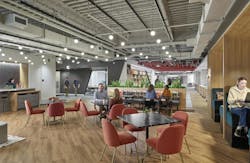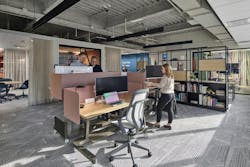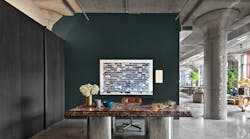Evolving Workspaces: Lessons in Flexibility, Communication, and Comfort
It has been more than four years since everything we knew about work was flipped on its head. As the dust settles, we are still learning valuable lessons and insights into the future of work due to this disruption. Prior to the pandemic, alternative workplace solutions slowly evolved over the years with the amount of remote work time only doubling every 15 years. With the pandemic forcing nearly everyone to work from home, the acceleration of change created a trajectory that under our pre-COVID system would have taken more than 40 years to realize.
While both employers and their employees were forced to quickly adapt to this new way of working, the expectations placed on the physical workplace were twofold. On the one hand, the established worker who was familiar with the typical five days per week in-person experience was enlightened in all the ways the office of the past did not serve their needs. On the other hand, an entire generation was just entering the workforce for the first time. With hybrid and remote policies as the primary working model, many Gen Z employees are skeptical of the value of the office’s collective experience. Our challenge as workplace designers is finding the balance between these vastly different sets of expectations to ensure the office supports all staff and to prove the value of the physical office so that it is used to its full potential.
When designing FCA’s Philadelphia headquarters, we focused on user engagement to get insights into how the staff visualized using the space through several visioning sessions and surveys. Now that we’ve been in the space for over a year, we are taking the time to reflect and get post-occupancy feedback on what was successful and identifying areas we can improve. These lessons will serve us in future projects but will also allow us to continue to evolve and adapt our workplace in the years to come, to ensure it continues to support our staff as much as possible.
The feedback we received highlighted three key takeaways: the importance of adjustability and flexibility, the need for clear and effective communication and legibility, and the importance of balance and comfort in the workplace experience. We’ve outlined ways to implement these lessons learned to all users’ benefit.
Adjustability and Flexibility
Our experience at headquarters showed that customization of the workspace configuration, conditions, and furnishings made an impact.
Ergonomic, adjustable furniture allows users to adjust and personalize their workspace to best suit their unique needs. Choose furniture appropriate to the task that supports long and short durations and helps ease transitions between activities. Survey results indicated height-adjustable desks were one of the most utilized features in the new office.
Moreover, distinct types of work require different solutions. Rather than assigning employees to a single workstation, offering a range of work points allows users to choose the best place to work depending on the task. A combination of sitting, standing, and relaxed postures provides users with the autonomy to meet their diverse needs and helps to increase productivity and engagement.
Light exposure also has an enormous impact on mood and productivity, so dimmable overhead lighting and supplemental task lighting gives users a sense of control over their environment. Thermal comfort also greatly impacts productivity but is harder to achieve due to individual preferences. Temperature controls and devices assist in providing a comfortable environment for all occupants.
A flexible hybrid policy allows employees to choose when and how often they come into the office, further empowering staff to engage with the office on their own terms. A free address policy allows staff to choose and change where they sit throughout the day, in turn creating a productive and engaging environment.
Communication and Legibility
None of the configurable elements in the office would be leveraged without an understanding of what’s available. If spaces are outfitted with tools that enable hybrid working but are not effectively communicated to the people using them, they will go unused and will ultimately have a negative impact on the user experience. Instructions on how to use technology and where and how to adjust the lighting and temperature will help to ensure the space is being used as intended.
With the introduction of multiple non-traditional work points, legibility is important in creating a successful project. Work settings should be thoughtfully designed to create a space that a user can enter and immediately understand how the space should be used. Similarly, designing a space which can be easily navigated through clear wayfinding is also critical. Amenities are another important part of the contemporary office. Highlighting any new office amenities or features, such as cafés with healthy food and drink options, will help employees make informed decisions about where and how to work in the office. These offerings have been proven desirable in a hybrid office and may help to draw employees into the space.
While engagement in the office is largely about the built environment, company policies also play a critical role in showing that employers are invested in the health and well-being of their employees. Communicating any new office or hybrid policies and identifying what initiatives are available will ensure staff can take full advantage of company offerings.
Community and Comfort
One of the biggest functions of the physical office in the past few years has been a social hub. Our survey results indicated the top three reasons people come into the office are for socialization, in-person events, and collaborating with colleagues, thus highlighting the importance of providing vibrant, dynamic social spaces with amenities that encourage employees to engage with one another.
Still, restorative spaces are key for meeting a variety of needs throughout the day. Areas of respite such as wellness rooms allow opportunities for restoration, and enclosed focus rooms with enhanced acoustics provide the necessary balance between work and play.
A personalized office with reminders of home helps the space feel inviting and approachable to allow employees to feel comfortable and at ease. Photographs, plants, and whimsical accessories invoke a sense of playfulness and thoughtfulness to create moments of delight for staff.
Finally, whether it’s through after-hours events, group activities, or tabletop games for a quick mental break, providing opportunities for staff to come together will help foster the sense of community that is often lost with remote work. Designing an accessible space that provides an equitable experience ensures all staff feel welcome and comfortable coming into the office.
No Static Spaces
Looking into the future, as interior designers we recognize that workplace design is not a prescriptive, one-size-fits-all solution. We constantly adjust our strategies through user feedback, neuroscience, and lessons learned over the past few years. The demands of work and culture are ever evolving, challenging us to stay current and seeking ways to improve. Focusing on how spaces make us feel and listening to feedback will not only keep everyone engaged but will allow us to design thoughtful spaces with the user front of mind.





